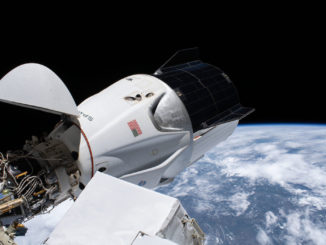A camera riding on Japan’s Hayabusa 2 spacecraft recorded stunning views of the probe’s final descent to asteroid Ryugu last month, showing the rocky debris kicked up by the robot explorer’s touch-and-go landing to collect a sample for return to Earth.
The on-board camera observed Hayabusa 2’s sampling horn contact Ryugu’s gravelly surface Feb. 21, when the spacecraft briefly touched down and fired a tantalum bullet into the asteroid, blasting bits of rock and powder into the probe’s sample collection chamber.
The video released by the Japan Aerospace Exploration Agency on Tuesday shows Hayabusa 2 beginning its final descent from a hover position around 28 feet (8.5 meters) above the asteroid, then free-falling to Ryugu, pulled by the asteroid’s tenuous gravity. After shooting the asteroid with the projectile, Hayabusa 2 fired rocket thrusters to begin its climb back into space as bits of rock thrown away from Ryugu float nearby.
JAXA says the video released Tuesday runs at five times normal speed. The camera that captured the spectacular imagery was built and installed using donations from the public.
Scientists declared the touch-and-go operation a success, and mission managers are confident Hayabusa 2 snared a sufficient sample from Ryugu. Ground controllers commanded Hayabusa 2 to seal the chamber containing the collected asteroid specimens for return to Earth.
Hayabusa 2 is around halfway through its roughly 18-month stay at asteroid Ryugu, and the spacecraft’s touch-and-go Feb. 21 accomplished one of the mission’s prime objectives. Next up will be Hayabusa 2’s release of an impactor to strike the asteroid and carve a artificial crater, exposing subsurface rock materials for another sampling attempt later this year.
Hayabusa 2 could return to Earth with at least 100 milligrams of asteroid material, enough for scientists to analyze Ryugu’s chemical composition, revealing information about the object’s history and evolution. The results could yield clues about how water and organic molecules were delivered to Earth in the ancient solar system.
Shaped like a spinning top, Ryugu measures nearly 3,000 feet (900 meters) in diameter and is rich in carbon. Scientists classify Ryugu as a C-type asteroid, and Hayabusa 2’s target crosses Earth’s orbit on each 1.3-year loop around the sun, making it a potentially hazardous object that could eventually strike our planet.
The asteroid probe’s next job will be to survey the planned location for deployment of the impactor, which is scheduled to be deployed in the first week of April. Hayabusa 2 will fire the copper impactor at high speed, creating a crater revealing pristine rock for Hayabusa 2 pick up on a second touch-and-go maneuver.
But Hayabusa 2 will first descend close to the asteroid once again in late April to examine the crater before officials determine if the area is safe enough to proceed with the mission’s second sampling attempt. If managers approve the plan, Hayabusa 2’s second touch-and-go on Ryugu is scheduled some time after May.
The spacecraft will release the last of four tiny robotic landers it carried to Ryugu some time after July, according to an updated mission timeline released by JAXA this week. Hayabusa 2 delivered three hopping robots to Ryugu — two from Japan and one from Europe — last September and October.
Mission planners originally intended Hayabusa 2 to collect samples from three locations on the asteroid, but officials this week said a third sampling attempt is unlikely before the probe leaves the asteroid.
The mission is scheduled to depart Ryugu in November or December, using ion thrusters for the return trip to Earth, where Hayabusa 2’s sample return capsule will parachute to a landing in Australia in late 2020.
Email the author.
Follow Stephen Clark on Twitter: @StephenClark1.



